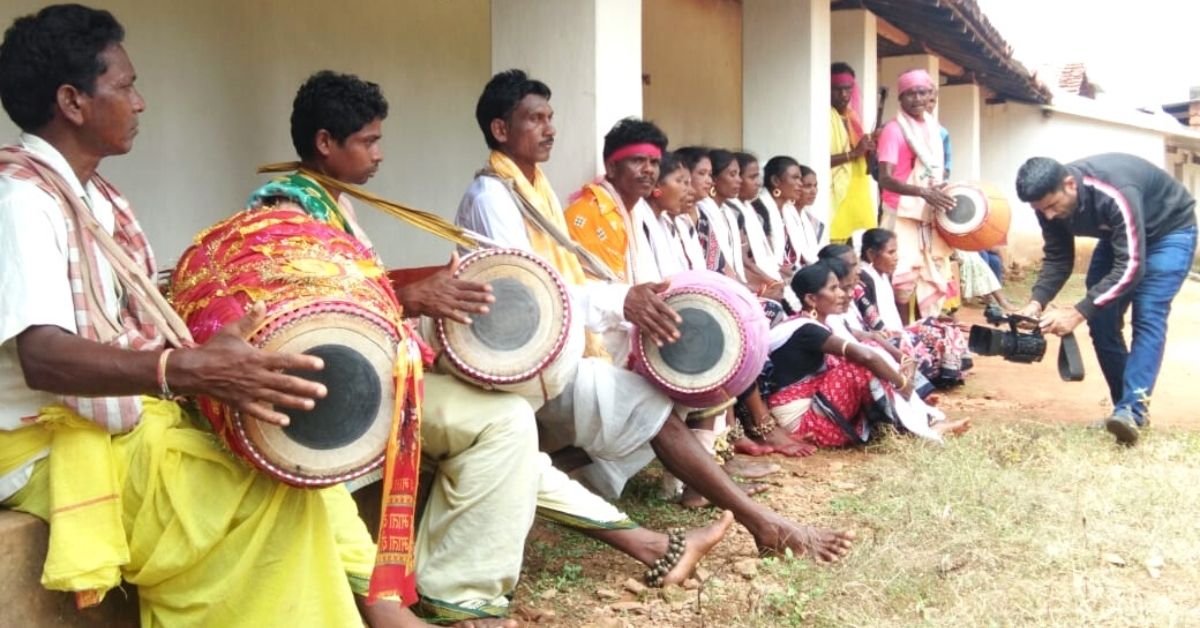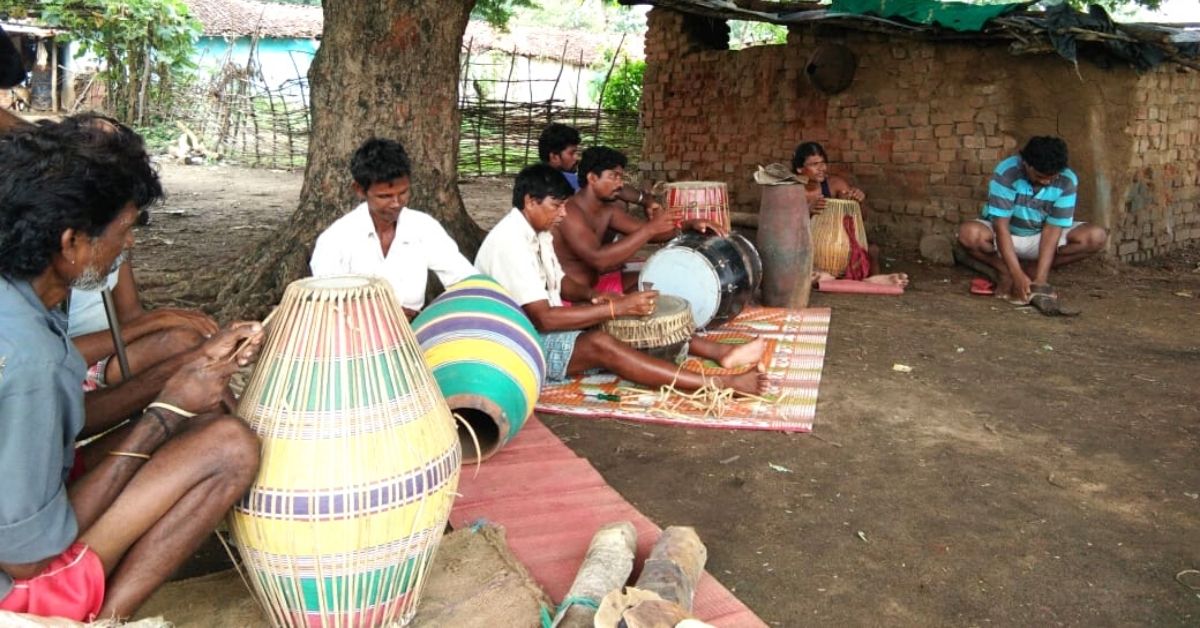Meet the Zoology Lecturer Travelling to 1000 Villages To Revive Near-Extinct Folk Art
Odisha’s Rajat Kumar Panigrahi is a zoology lecturer by day. But when office hours conclude, he dons another role — that of a preserver of folk art and music, through his online repository Matir Kala

Rajat Kumar Panigrahi is a zoology lecturer at Yuvodaya College in Balangir of Odisha by day. But when office hours conclude, he dons another role — that of a preserver of folk art and music.
Sometimes, he travels for hours and spends many sleepless nights trying to reach the remotest villages of western Odisha. He tries to locate folk artists and musicians, and document their rare art forms that are seldom found on popular platforms.
“These villages are so isolated that even the cell phone network has not reached them in the 21st century. The only way to reach out to people here is by paying them a visit,” he tells The Better India.
Using social media to document rare art forms

Rajat says his journey to preserve near-extinct forms of folk art began when he visited several such festivals. “In Rajkonna village, where I’m from, an annual event called Chhatar Yatra is organised. I attended it one time when I was a student, and realised that these folk arts are undocumented and probably do not exist on government or other records. But they have survived for centuries, having been passed on to younger generations. Moreover, the concerning fact was that they have become rare, and are on the verge of dying,” he says.
He says that like Chhatar Yatra, there were many more folk festivals held across the state that were unknown to the world, but disappeared quickly. “These art forms and festivals have no commercial interests, as they are niche and mostly specific to communities. Moreover, the artists have been deviating to other professions for survival. Many have given up these art forms as their profession and migrated to other cities,” he says.
He further explains, “The instruments used in traditional and tribal folk music are also under threat, as many are made from plastic, as against the conventional materials like wood and leather, because it’s cheaper. But this negatively affects the rhythm of the music instruments.”
Rajat started spending his college pocket money to reach out to these artists and help them buy instruments and other materials. His cousin Satya Panigrahi and friend Ganesh Pradhan also joined the initiative.
When they started, the trio met artists who used to play traditional instruments in social and cultural events but gave up due to a lack of commercial prospects. They helped them buy authentic musical instruments through networking. They also found original makers of these instruments and connected them to artists to increase their business. Rajat says that many artists they were working with began feeling more encouraged.
The trio then travelled to Sonepur, Kalahandi and Balangir areas to discover and document rare forms and artefacts. “We also found some instruments that were 60 years old,” he says.
Over the years, the group found and collected various traditional instruments, bamboo crafts from Naupada, old wood carvings from Kalahandi, and other handicraft and terracotta art pieces. They reached out to potential buyers as well.
“We also realised that these art forms could only be preserved if they are documented and encouraged in academia through research, as it would lead to a path where it will pass on to generations,” he says.
Rajat and his friends then started recording videos of folk events. “Satya became a videographer, and Ganesh took the task of editing the videos and explaining them to the audience. We started a page, Matir Kala, on Facebook and YouTube and uploaded these videos,” he says.
Since 2017, they have travelled thousands of kilometres covering over 1,000 villages in western Odisha for their cause. “We spend all of our incomes to help the artists by all means,” he says.
‘Some passions are beyond material benefit’

Their documentation involves the folk culture of the Chuktia Bhunjia tribe and folk instrument makers of Naupada, Kalahandi’s Ghumra dance, Devguru and Dalkhai folk tradition of Balangir and Bargarh, respectively.
“We have also documented Sarangi and Ghudka folk instruments in Balangir, Kisan folk dance in Sambalpur and folk instrument makers of Balangir, Sonepur and Nuapada,” he says.
Ganesh explains, “Generally, the Chini folk dance is performed by the Chakotia Bhunjia community living in Sunabeda sanctuary of Naupada. They perform the dance during special occasions like marriage ceremonies, often by singing songs in their Bhunjia language. Folk instruments like dhol, nisan, tasa, muhuri and jhan are used during the performance, which have a peculiar rhythm and vibe.”
But Ganesh says the dance form, which has been celebrated since ancient times, is gradually seeing threats from modern trends such as sound box systems, DJs, and other music alternatives. “Their interference has caused the folk art to shrink in performance numbers. Also, the younger generations are not keen on learning the dance form, as they prefer other forms of entertainment,” he explains.
The team members at Matir Kala enlist locals and create awareness of the importance of the traditions among the youngsters. “We try to bring a religious connection to it and also provide folk instruments for free. Such associations and efforts are aimed to create change in mindset and encourage the younger generation to reconnect with the art,” he says.
Speaking about the folk instrument Dhunkel, Ganesh says, “It is one of the oldest folk instruments of Odisha and played only during Devi Pujan event for Dussehra. The instrument is made from new clay pot, bamboo and ring made from paddy straw and others.”
The artists who play these instruments are called Dhunkelia. The art has less prospects in terms of commercial gains, since the instrument is played only once a year, Ganesh notes.
“We are finding it challenging to find Dhunkelias, as there are only a few. But we have identified a few who have dedicated over five decades to this form of folk music, and created a documentary. It is also available on YouTube. We hope new artists feel inspired to stop their craft from going extinct,” he says.

Rajat says that thanks to their work, many universities have now included these art forms and instruments in their syllabus and curriculum. “Many students abroad are researching these rare art forms and using our work as citations and references.”
Moreover, their work has inspired many artists to return to villages and resume their professions, he adds.
Sarbe Swarbhoy, a folk singer from Jharan, says he had given up on performances due to a lack of commercial prospects. “The number of performances had decreased, and I received fewer invitations. But Rajat helped me with the network and connected me with people who valued my unique skills,” he says.
He adds that he now receives considerable opportunities which encourage him to keep folk music alive. “I have decided never to give up on my singing ever again,” he says.
Rajat says many of his colleagues or close friends often question him about his work. “They ask me why I spend all the money helping the artists and reviving the old folk art. They ask me about its benefits and what I will achieve. But I try to explain to them that some passions are beyond material benefits. I tell them that I am doing this for atma trupti (getting satisfaction for my soul),” he says.
Edited by Divya Sethu
If you found our stories insightful, informative, or even just enjoyable, we invite you to consider making a voluntary payment to support the work we do at The Better India. Your contribution helps us continue producing quality content that educates, inspires, and drives positive change.
Choose one of the payment options below for your contribution-
By paying for the stories you value, you directly contribute to sustaining our efforts focused on making a difference in the world. Together, let’s ensure that impactful stories continue to be told and shared, enriching lives and communities alike.
Thank you for your support. Here are some frequently asked questions you might find helpful to know why you are contributing?


This story made me
-
97
-
121
-
89
-
167













